Traditionally, metal ceilings are used in industrial buildings and utilitarian areas. However, times have changed as the direction of this element within modern architecture is leading to it being a fashionable and functional feature as well. Traditionally, metal ceilings were used on account of their durability and ease of maintenance; more recently, they have been adopted for their aesthetic appeal and versatility. This blog post expresses the role that metal ceilings play in current architectural studies, further into benefits, popular design trends, environmental impact, and new inventions yet to come.
Benefits of Metal Ceilings-
1. Durability: Arguably, the flexibility of metal ceilings is one of the most outstanding advantages of improved health care facilities. Unlike other materials such as the dry wall or plaster, metal can last for a long time without wearing out due to moisture, pest or even physical damage. The American Institute of Steel Construction has it that metal ceilings can last more than 30 years without much attention being given to them.
2. Aesthetic Versatility: Metal ceiling are available in different finishes, colors and textures that makes it possible to create masterpieces for any room. For example, brushed aluminum in the *Oculus* at the World Trade Center (see Figure 3) is now the center of attention of the structure and demonstrates how metal can be functional as well as aesthetic.
3. Sustainability: In the current world, where sustainability is the order of the day, metal ceilings are unique since they can be recycled. A large number of metal ceiling products are produced with recycled materials and, when they reach the end of their life cycle, they can be recycled. The *U.S. Green Building Council* still notes that using such materials can help in the attainment of leadership in Energy and Environmental Design or LEED, and thus metal ceiling is green.
4. Acoustic Properties: They can also provide enhanced sound quality in the room as well as add a finish to the ceiling. If well designed, they can do as well work as a sound absorbers and reflectors suitable for use in places such as concert halls as well as open plan offices. For instance, the *New York Times Building* incorporates a metal ceiling to address issues of Acoustics and at the same time gets a touch of its classy looks.
Design Trends and Applications
Use of metal ceilings has seen a comeback in many architectural situations.
1. Residential Spaces
Now, in residential design, steel ceilings are being used to achieve impressive focus points. People have been considered to install tin tiles in the kitchen or the living space to give it a feel of old vintage combined well with modern interior designing.
2. Commercial and Institutional Use
Metal ceilings are primarily used to achieve an industrial chic aesthetic for business establishments. Restaurants like The Smith in New York make use of exposed metal ceilings that create a more enjoyable dining environment with function and form combined cohesively.
3. Innovative Designs
Innovative applications of metal ceilings include perforated panels that allow for unique lighting effects and ventilation. A stunning example is the use of metal to create apparently seemingly organic spaces that combine spectacular form and functionality can be seen in the Austria’s *Kunsthaus Graz*.
Environmental Impact and Sustainability
Unlike traditional ceilings, metal ceilings are not only recyclable but also possess many environmental advantages.
Metal ceilings can contribute to energy efficiency by reflecting heat and light, reducing the need for artificial lights and climate control. This may save on the energy bill and result in fewer carbon footprints for buildings. Reflective metal surfaces reflected the view of the Department of Energy, stating that it would save between 10% to 20% from cooling costs.
Metal ceilings support sustainable construction due to the promotion of energy efficiency and less waste during production. In addition, many producers embrace environmentally friendly methods of production and use of friendly materials that increase the sustainability of metal ceilings.
Installation and Maintenance
Though the virtues of metal ceilings are evident, knowing how they are installed is worth knowing. They can be installed suspended or attached directly to the roof deck. In either case, the plan of installation may consider the metal type and the building structure. Proper alignment and attachment require professional installation in most cases.
Maintenance requirements of metal ceilings are low, but they need to be cleaned regularly in order not to gather dust and to maintain their visual appearance. Scratches and dents have to be addressed immediately in order not to result in rust.
Cost and ROI
Regarding metal ceilings, one of the most critical factors involved is cost.
Metal ceilings are an expensive upfront investment but durable materials with low maintenance cost, often creating a good return on investment. It has been reported by the National Association of Home Builders that homeowners can gain up to 80% ROI when using quality materials, such as metal ceilings.
Compared to other materials of ceilings, metal ceilings would prove to be cost-effective in the long term. Besides the longevity and minimal upkeep that offset the costs incurred in the initial stages, they can always prove to be a wise decision for both residential and commercial applications.
Future Trends and Innovations
The future of metal ceilings seems bright with the advancement of technology. Trends in new scenes include incorporation of smart techniques into metal ceiling designs, such as lighting and acoustic systems that change with the environment. Other innovations in manufacturing techniques allow for the production of almost any design an architect can envision to meet their needs.
In the future, the line of metal ceilings will probably be dictated by various changes in materials, like light alloys and paint for better scratch resistance and an attractive surface that still lasts long.




